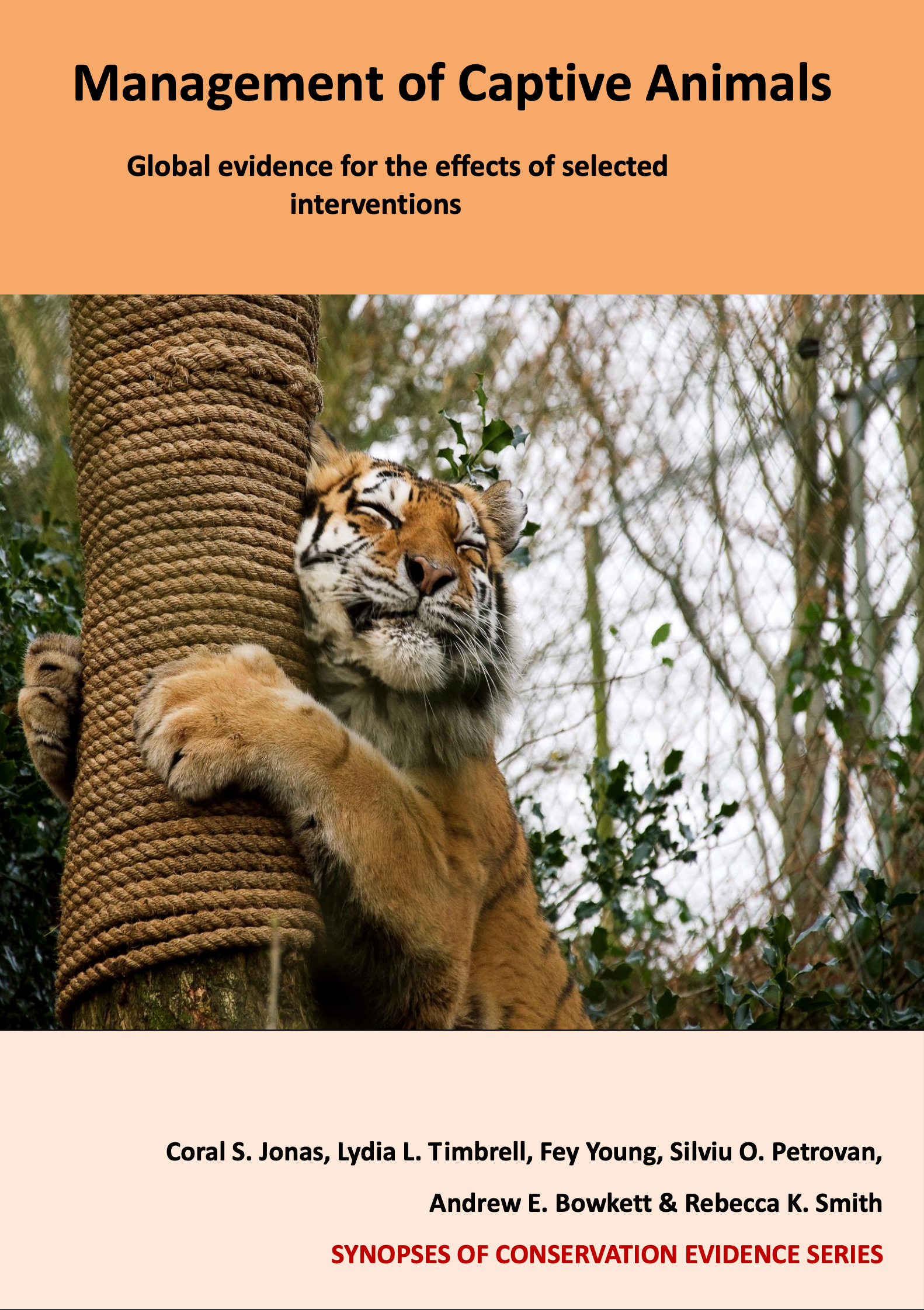Carnivores: Present food frozen in ice
-
Overall effectiveness category Likely to be beneficial
-
Number of studies: 4
View assessment score
Hide assessment score
How is the evidence assessed?
-
Effectiveness
70% -
Certainty
52% -
Harms
10%
Study locations
Supporting evidence from individual studies
A small replicated, before-and-after study in 1989 of a Kodiak brown bear Ursus arctos middendorffi, an Asiatic black bear Selenarctos thibetanus and two polar bears Ursus maritimus in a zoo in the USA found that providing food inside ice blocks increased active behaviours and decreased passive and abnormal behaviours in the first year of observation compared to non-enriched conditions. When provided with fish in frozen iceblocks, bears spent more time engaged in behaviours classed as active (49.6% of observations), less time in passive behaviours (47.6% of observations) and performed fewer abnormal behaviours (2.8% of observations) compared to non-enriched conditions (active: 19.4%, passive: 73.3%, abnormal: 7.3% of observations). These results were only significant in the first year of observations. Four solitary-housed bears were studied using instantaneous focal sampling at one-minute intervals, each exhibit was sampled once every five minutes during two 30 minute sessions a day, three days a week, over five months in 1989 and four months in 1990. For the Kodiak and polar bears the enrichment consisted of plain ice blocks and whole mackerel frozen inside ice blocks. For the Asiatic black bear the ice blocks contained peanuts, apples, raisins, peanut butter and grape jelly. These items were also scattered around the enclosure for the black bear.
Study and other actions testedA small replicated, before-and-after study in 1994 of African lions Panthera leo in a zoo in the USA found that when presented with fish frozen in ice, manipulation and gnaw/licking, stand/locomoting and sniff/flehmen behaviours increased compared to no enrichment. The frequency of paw manipulation (22.3 per 30 minutes), gnaw/lick (36.67 per 30 minutes), stand/locomote (26 per 30 minutes) and sniff/flehmen (6.33 per 30 minutes) all increased when presented with fish in ice-blocks compared to baseline data (paw manipulation: 0; gnaw/lick: 0; stand/locomote: 6.33; sniff/flehmen: 1.13). Two adult lions and two sub-adults were all fed at 17:00 h daily (3.1 kg chopped horse meat) and were fasted one day a week. Instantaneous scan sampling was used at 20-second intervals for two-hour periods for 24 days and included baseline data when no enrichment was provided. One-zero sampling was also used on specific behaviours to measure the occurrence of rare behaviours, including: licking/gnawing, paw manipulation, sniffing/flehmen and face rubbing/back roll. Different enrichments were provided at random due to availability. Fish frozen in balls of ice were presented to the lions, hanging logs and various scents were also placed around the enclosure on different occasions.
Study and other actions testedA replicated, before-and-after study in 2007 of tigers Panthera tigris, ocelots Leopardus pardalis, jaguars Panthera onca, cougars Puma concolor, cheetahs Acinonyx jubatus and lions Panthera leo in a zoo in the USA found that when provisioned with fish frozen in ice, active behaviours increased and stereotypic behaviours decreased compared to no enrichment. Active behaviours (51%) increased and stereotypic behaviours decreased (4%) when provided with fish frozen in ice compared to the baseline (active: 16%; stereotypic: 27%). Active behaviours also increased with the provision of bones and scattered spices and stereotypic behaviours decreased with the provision of scattered spices. The study was conducted on fourteen cats. Baseline data was collected before the investigation and two weeks of no enrichment occurred between each treatment. The three treatments included: 1) horse knuckle or shank bone daily for seven consecutive days (tiger was four days and jaguar not given); 2) Trout in a frozen soda bottle, daily for eight consecutive days (tiger was five days); 3) 30 ml of cinnamon, chili powder and cumin were sprinkled around the enclosure daily for nine consecutive days (tiger was five days). Each felid was observed for one 30-minute session/day for ten days over a period of four weeks prior to enrichment and for two 30-minute session/day over three days during treatments using instantaneous scan sampling.
Study and other actions testedA small replicated study in 2010 of grizzly bears Ursus arctos horribilis in a research facility in the USA, found that when food was presented simultaneously in ice-blocks and unfrozen, the bears spent less time manipulating and investigating frozen food compared to the unfrozen food. When apples and salmon were presented in ice blocks, bears spent less time manipulating (apples: 27 seconds; salmon: 76 seconds) and investigating (apple: 4 seconds; salmon: 2 seconds) compared to the same items that were freely available (manipulate: 1122 seconds (apple), 874 seconds (salmon); investigate: 8 seconds (apples), 15 seconds (salmon)). Four bears were routinely fed at 07:00 h daily and given a snack at 15:00 h on their regular schedule. During the experimental condition, bears were presented with five foraging choices simultaneously: apples, apples in ice, salmon, salmon in ice and plain ice. Behaviour was recorded using continuous focal sampling for six one-hour observation periods per bear.
Study and other actions tested
Where has this evidence come from?
List of journals searched by synopsis
All the journals searched for all synopses
This Action forms part of the Action Synopsis:
Management of Captive Animals
Management of Captive Animals - Published 2018
Captive Animal Synopsis





)_2023.JPG)














